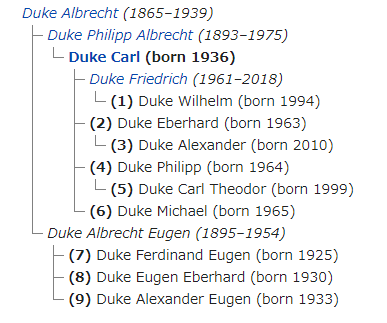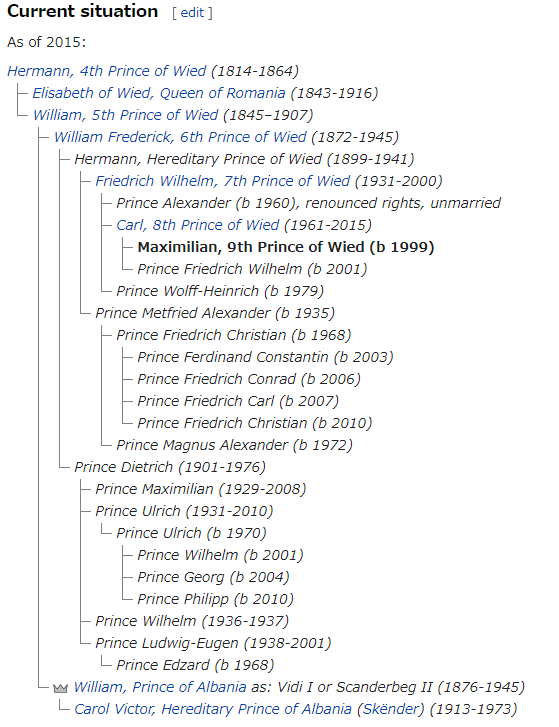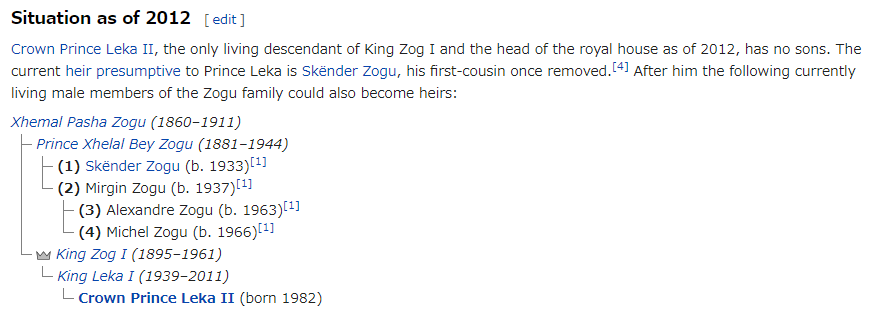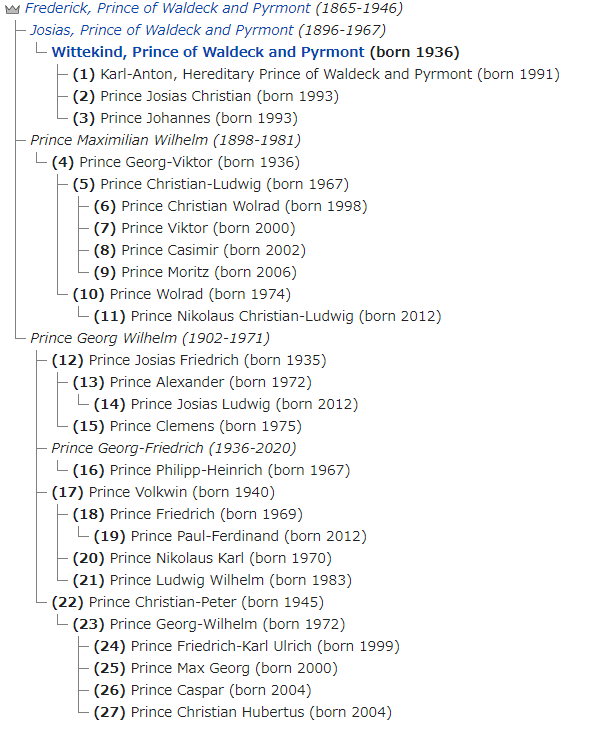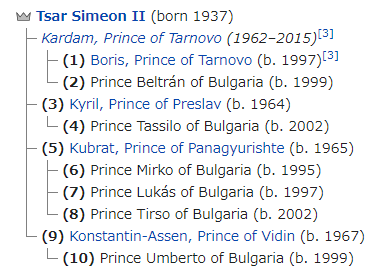note:
As of August 2020.
See also:
Line of succession to the former Monarchical throne and others : From (deleted) Wikipedia’s articles.
The succession order to the throne of the Romanian monarchy, abolished since 1947, was regulated by the monarchical constitution of 1938, suspended by the Royal Law Decree no. 3052 of September 1940 and the 1884 Law of the Romanian Royal House Rules enacted pursuant to the 1866 Constitution of Romania which had confirmed the enthronement of Prince Karl (Carol) of Hohenzollern-Sigmaringen. The 1938 Constitution stipulated Salic law, according to which the throne was hereditary in King Carol I’s legitimate descent and, if his male issue failed, in the descent of his brothers of the Sigmaringen princely branch of the House of Hohenzollern, according to agnatic primogeniture and to the perpetual exclusion of females and their descendants. The last monarch to reign in Romania was King Michael I, who was born in 1921, abdicated his throne on 30 December 1947 under coercion,[1][2][3] and went into exile in Switzerland. He died on 5 December 2017 in Aubonne, Switzerland.
Present situation
The last King, Michael I, had no sons, nor are there any undisputed legitimate male-line male descendants of the previous kings of Romania.
There are male line descendants of King Carol II: Paul of Romania (b. 1948), his son Carol Ferdinand (b. 2010), and Alexandru Hohenzollern (b. 1961). Paul and Alexandru are the sons of Mircea Carol Hohenzollern, also known as Mircea Carol Grigore of Romania (according to his Romanian birth certificate).[4][5] Mircea Carol (8 August 1920 – 27 January 2006) is the issue of King Carol II’s first marriage to Zizi Lambrino, which marriage had been declared null and void on 18 January 1919 by a Romanian court.[6] In 1955, however, a Portuguese court declared Mircea Carol as former King Carol II’s legitimate son, a ruling later confirmed by a Parisian court[citation needed]. The court rulings allowed him to bear the surname Hohenzollern and to inherit a portion of his father’s properties, but did not confer upon him any dynastic rights to the defunct Romanian throne or rights to bear a princely title and style, despite his use of both.[7] In October 1995 a Romanian court ruling also recognized Mircea Carol as a legitimate son of Carol II, allowing him the right to bear the surname “al României”, a ruling which evoked some speculation that called into question the status of Michael.[8] The court ruling was cited by Paul to assert a right to the title “Prince”.[5] The argument which appears prevalent is that Mircea Carol’s sons would not be entitled to succession rights, due to the non-dynastic nature of their grandparents’ marriage.[6] Moreover, Mircea Carol never claimed any right to the Romanian throne,[9] unlike his son, Paul.
Following King Michael’s abdication, the line of succession was discussed during a meeting between Michael, his uncle Prince Nicholas of Romania, and Frederick, Prince of Hohenzollern (1891–1965). Shortly after this meeting, the spokesman of Carol II, in an interview with the French paper Le Figaro, said that Carol, who was not in contact with Michael, strongly supported Prince Frederick, additionally asserting that Michael would never regain the throne.[10]
According to the succession provisions of the kingdom’s suspended constitution, that of 1938, agnatic primogeniture and so-called “Salic law” determine who would inherit the throne. After two intervening changes of regime, that constitution no longer carries legal weight, although the 1884 Law of Romanian Royal House Rules was never abrogated.[11] It must also be said that the remaining current German Hohenzollerns in the succession line descend from the previously mentioned Prince Frederick and his brother Prince Franz Joseph, the sons of Wilhelm, Prince of Hohenzollern (Wilhelm’s father, Prince Leopold renounced his rights in 1880), who renounced his rights to the Romanian throne, on 20 December 1886,[12] in favor of his younger brother, the future King Ferdinand.[13]
Male-preference primogeniture
On 30 December 2007, the 60th anniversary of his loss of the throne, the former King Michael issued the Fundamental Rules of the Royal House of Romania.[14] in which he again appealed to the Romanian Parliament to alter the Salic Law of succession, should the Romanian nation and Parliament consider restoring the monarchy in the future,[14] and calling for the first in line of succession to be Michael’s eldest daughter, newly titled “Crown Princess of Romania” and “Custodian of the Romanian Crown”. This decree was explicitly based on “the values of Romanian society” and on EU legislation, specifically the European Convention on Human Rights (which, however, does not guarantee any right to reign as a monarch in any country). The document clarifies the order of inheritance of Michael’s fortune and claim to the Romanian throne. The private castles of the former monarch in Romania – Săvârșin and Pelișor – are to be held by the successor in this line.
It is an act with eminently symbolic importance in the absence of its approval by the Parliament,[11][15] and the declaration is alleged by some to be undemocratic.[16]
It also attempts to replace the 1884 Statutory Law. According to this private statute Michael had, in 1997, already designated his oldest child (Margareta) as successor to “all” his “prerogatives and rights”, indicating his desire for a gender-blind succession to the throne.[17][18] Only the Parliament could amend the succession rules together with the Constitution in which they had been included, assuming the monarchy were first restored.
The line of succession, as published in Addendum I of the 2007 Statute, modified by Michael in 2014 to remove his daughter Irina and her children and grandchildren,[19] and then modified again in 2015 to remove his grandson Nicholas,[20] consists of:[14]
- King Michael I (1921–2017)
- Princess Margareta (born 1949)
- (1) Princess Elena (b. 1950)
- (2) Elisabeta Karina de Roumanie Medforth-Mills (b. 1989)
- (3) Princess Sophie (b. 1957)
- (4) Elisabeta Maria de Roumanie Biarneix (b. 1999)
- (5) Princess Marie (b. 1964)

As the above list exhausts all the dynastic members of the present Royal House of former king Michael I, the line would not continue with the German Hohenzollerns mentioned above. In fact, this private Statute through Addendum I, explicitly allows only direct descendants of King Michael as dynasts; unlike the old succession rules, the German Hohenzollerns are no longer mentioned as potential dynasts. Contrary to a specific provision of the 1923 Constitution, the private Statute bars from the succession any prince from another, foreign dynasty.
According to the former President of Romania Traian Băsescu, who does not appreciate Crown Princess Margareta’s husband,[21] the Romanians seem to think that were the monarchy restored, Radu would become their king (king consort), something which, according to Băsescu, impacts negatively the Romanians’ public perception of the idea of monarchy.[22][23]
Succession by Salic law
- Leopold, Prince of Hohenzollern (1835–1905)
- Wilhelm, Prince of Hohenzollern (1864–1927)[12]
- Friedrich, Prince of Hohenzollern (1891–1965)
- Friedrich Wilhelm, Prince of Hohenzollern (1924–2010)
- Karl Friedrich, Prince of Hohenzollern (born 1952)
- (1) Alexander, Hereditary Prince of Hohenzollern (b. 1987)
- (2) Prince Albrecht of Hohenzollern (b. 1954)
- (3) Prince Ferdinand of Hohenzollern (b. 1960)
- (4) Prince Aloys of Hohenzollern (b. 1999)
- (5) Prince Fidelis of Hohenzollern (b. 2001)
- Prince Johann Georg of Hohenzollern (1932–2016)
- (6) Prince Carl Christian of Hohenzollern (b. 1962)
- (7) Prince Nicolas of Hohenzollern (b. 1999)
- (8) Prince Hubertus of Hohenzollern (b. 1966)
- (9) Prince Ferfried of Hohenzollern (b. 1943)
- Prince Franz Joseph of Hohenzollern (1891–1964)
- Prince Emanuel of Hohenzollern (1929–1999)
- (10) Prince Carl Alexander of Hohenzollern (b. 1970)
- King Ferdinand I (1865–1927)
- King Carol II (1893–1953)
- Carol Lambrino (1920–2006) X
- Paul-Philippe Hohenzollern (b. 1948) X
- Carol Ferdinand (b. 2010) X
- Alexander Hohenzollern (b. 1961) X
- King Michael I (1921–2017)
Notes:
- X Excluded due to the annulment of Carol II’s marriage to Zizi Lambrino.

In case of the extinction without any direct male heirs of all eligible Hohenzollerns or of their refusal to accept the throne, according to article 35 of the last royal Constitution of Romania from 1938,[24] the throne becomes vacant. In this situation, article 35 provided that the last reigning king had the right to nominate a foreign prince from a reigning dynasty of Western Europe as successor, subject to the Parliament’s approval as required by article 36. The Parliament incurs the final responsibility, according to article 36, of electing a king from a reigning dynasty of Western Europe if, prior to his investiture, he had committed to raise his descendants in the Eastern Orthodox faith to comply with article 34 of the Constitution.
In 1997, Romanian monarchist leaders asked former King Michael to designate a male heir presumptive from the German branch of the family, in keeping with the rules of the last royal constitution. Under the influence of his wife Anne, the former King rejected the request and, at the end of 1997, he illegally designated his first born, Princess Margarita, as heir presumptive.[25]
In a 2009 interview, Karl Friedrich, then Hereditary Prince of Hohenzollern, stated that he was not interested in the Romanian throne.[26]
Line of Succession in December 1947
- Leopold, Prince of Hohenzollern (1835–1905)
- Wilhelm, Prince of Hohenzollern (1864–1927)[12]
- (2) Friedrich, Prince of Hohenzollern (b. 1891)
- (3) Friedrich Wilhelm, Hereditary Prince of Hohenzollern (b. 1924)
- (4) Prince Franz Josef of Hohenzollern (b. 1926)
- (5) Prince Johann Georg of Hohenzollern (b. 1932)
- (6) Prince Ferfried of Hohenzollern (b. 1943)
- (7) Prince Franz Joseph of Hohenzollern (b. 1891)
- (8) Prince Karl Anton of Hohenzollern (b. 1922)
- (9) Prince Meinrad Leopold of Hohenzollern (b. 1925)
- (10) Prince Emanuel of Hohenzollern (b. 1929)
- King Ferdinand I (1865–1927)
- King Carol II (b. 1893)
- Carol Lambrino (b. 1920) X
- King Michael I (b. 1921)
- (1) Prince Nicholas of Romania (1903-1978)
- Prince Karl Anton of Hohenzollern (1868–1919)
- (11) Prince Albrecht of Hohenzollern (1898-1977)
- (12) Prince Godehard of Hohenzollern (1939-2001)
